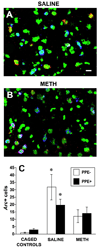Effect of methamphetamine neurotoxicity on learning-induced Arc mRNA expression in identified striatal efferent neurons
- PMID: 19073434
- PMCID: PMC2713000
- DOI: 10.1007/BF03033855
Effect of methamphetamine neurotoxicity on learning-induced Arc mRNA expression in identified striatal efferent neurons
Abstract
Methamphetamine abuse results in lasting, partial depletions of striatal dopamine and cognitive dysfunction. However, the effect of partial dopamine depletions on the expression of an effector immediate early gene, Arc (activity regulated, cytoskeletal-associated protein), known to be involved in synaptic modifications underlying learning and memory, has heretofore not been examined. Male Sprague-Dawley rats were pretreated with a neurotoxic regimen of methamphetamine or saline. Seven weeks later, rats were trained in a motor-response task on a T-maze for five days, and then underwent reversal training on day five. Rats were sacrificed 5 min after reaching criterion on the reversal task, and the brains were removed and processed using double-label fluorescent in situ hybridization for Arc and preproenkephalin (PPE) mRNA expression in the dorsomedial striatum. Rats pretreated with methamphetamine had an average (+/-SEM) 54.4+/-7.9% loss of dopamine in dorsomedial striatum. Interestingly, there was no difference in reversal trials to criterion in methamphetamine- vs. saline-pretreated rats. However, the expression of Arc mRNA in dorsomedial striatum was attenuated in methamphetamine-pretreated animals, particularly in PPE-negative neurons. Furthermore, the correlation between Arc mRNA expression in dorsomedial striatum and learning was abolished in methamphetamine-pretreated animals. These data suggest that methamphetamine-induced partial monoamine loss is associated with disrupted induction of the effector immediate early gene Arc during a behavioral task, particularly in PPE-negative (presumed striatonigral) neurons, as well as with disruption of the relation between Arc mRNA expression in dorsomedial striatum and reversal learning.
Figures




Similar articles
-
Arc mRNA induction in striatal efferent neurons associated with response learning.Eur J Neurosci. 2007 Jul;26(1):228-41. doi: 10.1111/j.1460-9568.2007.05630.x. Eur J Neurosci. 2007. PMID: 17614950
-
Disruption of subcellular Arc/Arg 3.1 mRNA expression in striatal efferent neurons following partial monoamine loss induced by methamphetamine.J Neurochem. 2012 Dec;123(5):845-55. doi: 10.1111/jnc.12017. Epub 2012 Oct 10. J Neurochem. 2012. PMID: 22978492 Free PMC article.
-
Altered learning and Arc-regulated consolidation of learning in striatum by methamphetamine-induced neurotoxicity.Neuropsychopharmacology. 2012 Mar;37(4):885-95. doi: 10.1038/npp.2011.265. Epub 2011 Nov 9. Neuropsychopharmacology. 2012. PMID: 22071872 Free PMC article.
-
Changes in neural circuitry regulating response-reversal learning and Arc-mediated consolidation of learning in rats with methamphetamine-induced partial monoamine loss.Neuropsychopharmacology. 2014 Mar;39(4):963-72. doi: 10.1038/npp.2013.296. Epub 2013 Oct 22. Neuropsychopharmacology. 2014. PMID: 24150570 Free PMC article.
-
Phasic-like stimulation of the medial forebrain bundle augments striatal gene expression despite methamphetamine-induced partial dopamine denervation.J Neurochem. 2013 May;125(4):555-65. doi: 10.1111/jnc.12234. Epub 2013 Apr 1. J Neurochem. 2013. PMID: 23480199 Free PMC article.
Cited by
-
Pulling habits out of rats: adenosine 2A receptor antagonism in dorsomedial striatum rescues meth-amphetamine-induced deficits in goal-directed action.Addict Biol. 2017 Jan;22(1):172-183. doi: 10.1111/adb.12316. Epub 2015 Oct 30. Addict Biol. 2017. PMID: 26515740 Free PMC article.
-
Methamphetamine neurotoxicity decreases phasic, but not tonic, dopaminergic signaling in the rat striatum.J Neurochem. 2011 Aug;118(4):668-76. doi: 10.1111/j.1471-4159.2011.07342.x. Epub 2011 Jul 1. J Neurochem. 2011. PMID: 21668447 Free PMC article.
-
Methamphetamine-induced neurotoxicity disrupts pharmacologically evoked dopamine transients in the dorsomedial and dorsolateral striatum.Neurotox Res. 2014 Aug;26(2):152-67. doi: 10.1007/s12640-014-9459-y. Epub 2014 Feb 22. Neurotox Res. 2014. PMID: 24562969 Free PMC article.
-
Long-term effects of exposure to methamphetamine in adolescent rats.Drug Alcohol Depend. 2014 May 1;138:17-23. doi: 10.1016/j.drugalcdep.2014.02.021. Epub 2014 Feb 26. Drug Alcohol Depend. 2014. PMID: 24629630 Free PMC article.
-
Reversal-specific learning impairments after a binge regimen of methamphetamine in rats: possible involvement of striatal dopamine.Neuropsychopharmacology. 2010 Jan;35(2):505-14. doi: 10.1038/npp.2009.155. Neuropsychopharmacology. 2010. PMID: 19794407 Free PMC article.
References
-
- Ariano MA, Grissell AE, Littlejohn FC, Buchanan TM, Elsworth JD, Collier TJ, Steece-Collier K. Partial dopamine loss enhances activated caspase-3 activity: differential outcomes in striatal projection systems. J Neurosci Res. 2005;82:387–396. - PubMed
-
- Aronin N, Difiglia M, Graveland GA, Schwartz WJ, Wu JY. Localization of immunoreactive enkephalins in GABA synthesizing neurons of the rat neostriatum. Brain Res. 1984;300:376–380. - PubMed
-
- Belcher AM, Feinstein EM, O'Dell SJ, Marshall JF. Methamphetamine influences on recognition memory: comparison of escalating and single-day dosing regimens. Neuropsychopharmacology. 2008;33:1453–1463. - PubMed
-
- Belcher AM, O'Dell SJ, Marshall JF. Impaired object recognition memory following methamphetamine, but not p-chloroamphetamine- or d-amphetamine-induced neurotoxicity. Neuropsychopharmacology. 2005;30:2026–2034. - PubMed
-
- Campbell BM, Gresch PJ, Walker PD. Neonatal dopamine depletion reveals a synergistic mechanism of mRNA regulation that is mediated by dopamine(D1) and serotonin(2) receptors and is targeted to tachykinin neurons of the dorsomedial striatum. Neuroscience. 2001;105:671–680. - PubMed
Publication types
MeSH terms
Substances
Grants and funding
LinkOut - more resources
Full Text Sources
Medical

